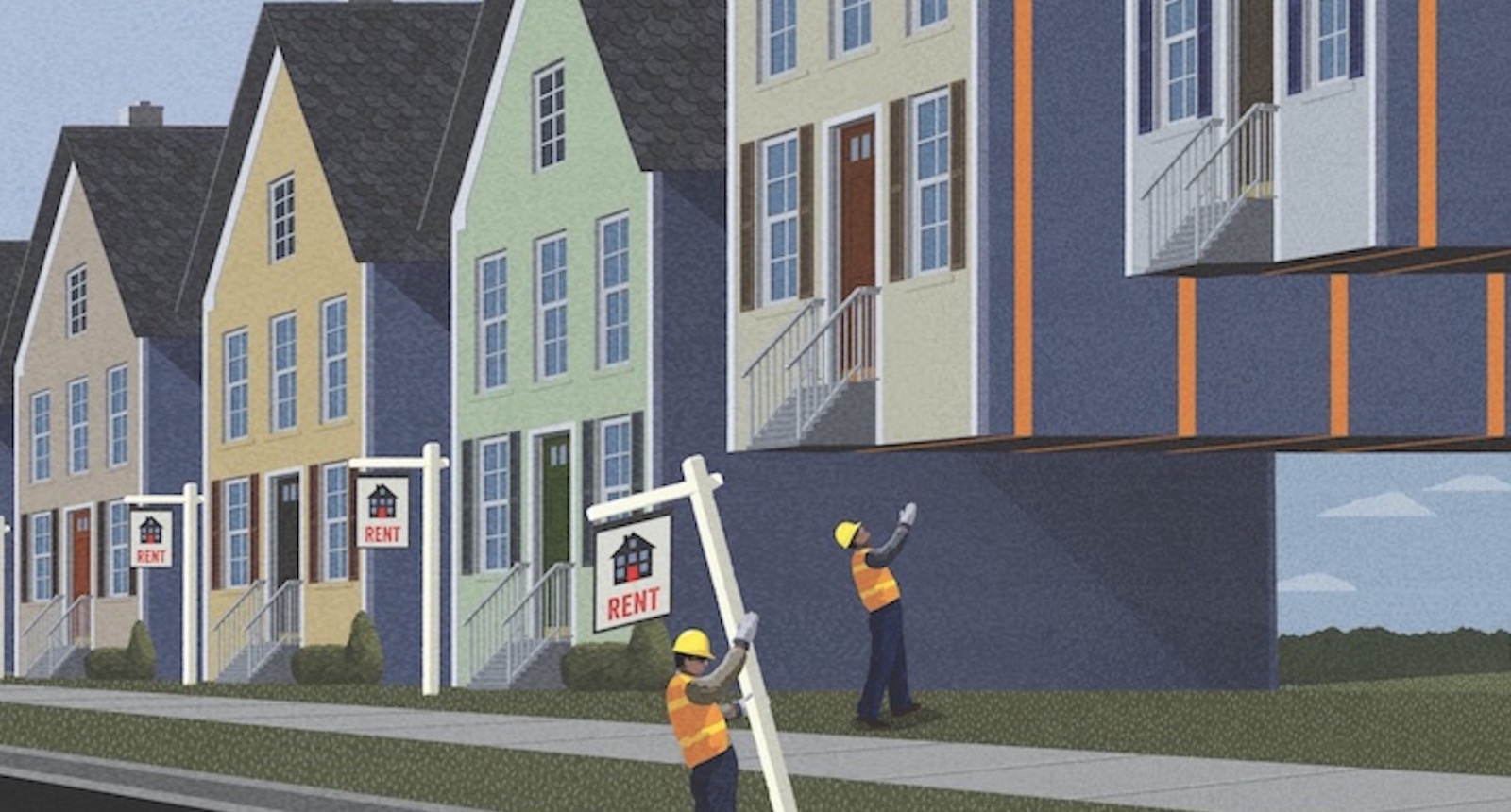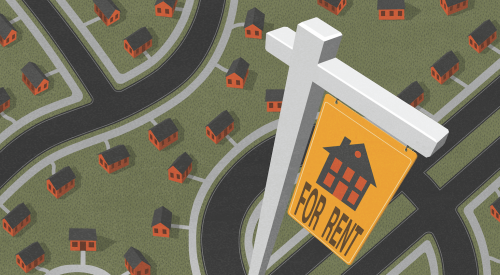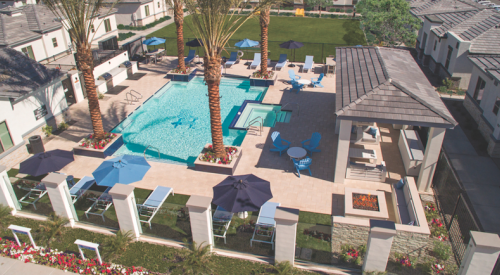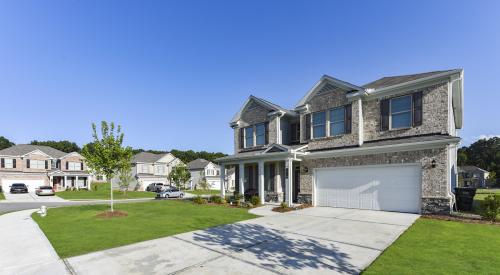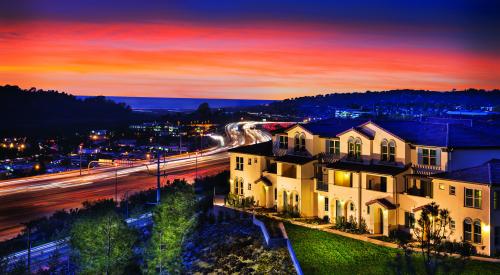On Oct. 13, ResiBuilt Homes, a 2018 startup that exclusively develops and builds dedicated rental communities (DRCs) of market-rate single-family homes, sold six projects in progress in Atlanta—a total of 537 homes at build-out—to Haven Realty Capital of El Segundo, Calif., for $133.7 million. And ResiBuilt has a pipeline of 3,300 more lots across a regional footprint and sufficient capital to expand its DRC model.
Earlier in the year, Christopher Todd Communities (CTC), a developer of luxury single-family rental neighborhoods based in Surprise, Ariz., announced it was selling five of its communities in Phoenix, a total of 943 homes, to an affiliate of The Inland Real Estate Group of Companies, in Oak Brook, Ill.
These deals, and others like them, accentuate some of the dynamics currently driving the single-family build-to-rent (SFB2R) market, including housing affordability, rent-by-choice preferences among some cohorts, and the unusual situation of equally hot home sales and rentals running parallel.
RELATED
- This Modern Life: A New Era of Building Modern Emerges
- Home Trends: What’s Current and to Come, According to the Experts
Both the ResiBuilt and CTC transactions are, first and foremost, further evidence that investor interest in single-family rentals is strong ... and getting stronger. “The capital investment appetite for it is huge,” says Michael Finch, EVP at SVN SFRhub Advisors, a Phoenix-based consulting and brokerage group. “There are billions and billions of dollars out there to finance homes that can be leased as fast as they can be built.”
And the market is responding. In the four quarters ending last October, builders started 42,000 SFB2R units, according to the National Association of Home Builders’ analysis of Census data. That represented about 4.5% of total home starts for the year, up slightly from the previous four quarters.
Of the estimated 43.8 million rental units currently occupied in the U.S., a third are single-family detached or attached homes, the vast majority being existing homes on scattered lots versus new construction, and even less so those in DRCs. The SFB2R and DRC movements are a “‘to-be-expected’ evolution,” says Gerald (Jerry) Ellenburg, chairman and CEO of ERC Homebuilders, in Riverview, Fla., as Millennials start families and search for good school districts, while aging Baby Boomers look to move down and shed maintenance duties. Meanwhile, the tax benefits for homeownership, such as the mortgage interest deduction, were diminished in the 2017 Tax Cuts and Jobs Act. And there are several investor groups of varying sizes clamoring to own and/or operate rental housing. “The investor demand is there, and it’s now an organized discipline,” Ellenburg says (see “The Investor Angle”).
"Single-family rental also allows builders to keep building during market corrections because people have to live somewhere." —Michael Finch, EVP at SVN SFRhub Advisors
A year ago, Ellenburg was on his way to raising up to $100 million of investor capital to finance the construction of 800 to 1,000 traditionally built single-family rental homes in multiple communities across Florida. But recognizing an even greater opportunity, he pivoted to a dedicated rental community of 60 manufactured HUD-code homes near Tampa scheduled to break ground this month (see “Manufactured to Rent”).
Finch isn’t surprised to see for-sale home builders jumping on the rental bandwagon. “It’s a good way to generate cash flow and to target the 40% of the country they weren’t able to reach otherwise,” he says. “Single-family rental also allows builders to keep building during market corrections because people have to live somewhere.”
What will be determined next, he contends, is which development model investors prefer: One like CTC’s or ResiBuilt’s, which market clusters of homes built on a single land parcel, or the more common model of building rental homes on individual lots that can be marketed to multiple investors separately.
Sudha Reddy, managing principal of Haven Realty Capital, sees more potential in the former. “Having an asset class in one location shows an efficiency that investors can understand,” he says. “It has unlocked better financing options.”
Build to Rent: Sorting Out the Options
Builders, developers, and investors are sorting out this housing sector by product type, community size, geographic location, and demographic demand.
Tenants are typically defined as either renters by necessity or by choice, including downsizing Baby Boomers and professionally mobile Millennials and Gen Yers who prefer the nimbleness of renting, or lack a down payment for a single-family home in the suburbs for their young families, especially as the red-hot for-sale market continues to push up prices. “The market is undersupplied in both segments,” Reddy points out.
“We provide convenience,” says Josh Hartmann, CEO of NexMetro Communities, in Phoenix. As of December, the company had 30 properties with 5,000 single-family built-to-rent homes either completed, under construction, or under contract in Phoenix, Dallas, Denver, and Tampa, and 10 more properties with about 1,900 homes in predevelopment.
NexMetro’s Avilla Homes gated neighborhoods feature single-floor detached rental homes with one, two, or three bedrooms and outdoor patios and backyards. The company uses third-party property managers but also has an on-site maintenance manager and property manager in every community.
Hartmann says his company’s communities average 150 homes, and the houses range from 650 to 1,250 square feet and fetch 15% to 25% rent premiums over nearby apartment options. RCLCo, a national real estate consulting firm based in Bethesda, Md., estimates that one-third of NexMetro’s renters within its 11 Avilla communities in Phoenix are Millennials, and 60% are single women.
NexMetro expects to close on more than 1,500 new homes under its Avilla brand in 2021. It has been working with RCLCo to evaluate markets for expansion and is considering Austin, Texas, Las Vegas, and Salt Lake City. “There’s a ton of capital chasing this niche,” Hartmann says.
Where NexMetro targets younger renters who don’t have children, other companies in the SFB2R space focus on families.
“We saw a growing need coming out of the downturn to provide three- and four-bedroom homes to the rental society,” Mark Wolf, founder and CEO of Costa Mesa, Calif.-based builder/developer AHV Communities, told CNBC. Unlike many of its competitors, AHV has been holding onto its rental houses, rather than selling them to investors.
Three-fifths of renters in communities owned by Clean Living Communities (CLC) are young families, according to Jordan Kavana, founder and CEO of Transcendent Investment Management, the private equity firm that formed CLC. The firm recently began buying new homes across the southeastern U.S. whose sizes are typically 15% to 20% larger than nearby apartments, according to RCLCo.
Big Builders Weigh in on SFB2R
“Capital is starting to understand this [SFB2R] business,” says Stuart Miller, executive chairman for Lennar, during the builder’s fourth-quarter earnings in January 2020. In the previous quarter, the nation’s largest builder in both revenue and closings had “daylighted” its single-family rental program, for which its home building operation will build and sell homes in bulk in communities where the land is owned by third parties, “with no lease-up risk to Lennar,” said Lennar CEO Rick Beckwitt. He projected SFB2Rs will account for about 1% of Lennar’s closings in 2020 but will have “a much more meaningful impact in 2021.”
This most recent activity, however, isn’t Lennar’s first trip to the rental rodeo: Five years ago, it opened an 80-unit community of single-family rental homes in Sparks, Nev., called Frontera at Pioneer Meadows.
Lennar is hardly the only national builder dipping its toe into the SFB2R market. Scottsdale, Ariz.-based Taylor Morrison has two properties in Phoenix where it will develop and build SFB2R communities of about 200 units each, says Darin Rowe, Taylor Morrison’s national Build-to-Rent president. Rowe joined the company in October from Meritage Homes, where he spearheaded Meritage’s build-to-rent relationships with real estate investment trusts (REITs).
In addition, Taylor Morrison entered into a strategic partnership in August 2019 with Christopher Todd Communities to build SFB2R communities in several markets, and has identified Charlotte, N.C.; Dallas; and Orlando, Fla., as some of the locales where it will build those homes marketed under the “Christopher Todd Communities at [insert location], Built by Taylor Morrison” brand.
"There are a lot of players coming into this market. They had a proven track record and were further down the road than other build-to-rent companies." —Darin Rowe, Taylor Morrison's national Build-to-Rent president
“There are a lot of players coming into this market,” Rowe says. Taylor Morrison chose to team up with CTC, he explains, because “they had a proven track record and were further down the road than other build-to-rent companies. They’ve already paid the dumb tax.”
And while neither Toll Brothers nor BB Living Luxury Rental Communities wanted to comment publicly about the joint venture it entered into in May 2019, the deal reportedly has Toll Brothers investing $60 million in a $400 million venture to build and operate SFB2R homes in Phoenix, Las Vegas, Denver, Jacksonville, Fla., Dallas, Houston, and Boise, Idaho.
On Feb. 25 last year, Charles Merdian, CFO at LGI Homes, told analysts that the builder had closed 583 SFB2R homes in 2019, representing 7.6% of its total closings. At the time, Merdian said that LGI expects its closings of SFB2R units, which LGI refers to as its “wholesale” business, would be similar last year as a percentage of total closings.
Merdian also noted that by increasing its SFB2R closings, LGI had seen a “favorable impact” on its overall operating expenses as a percentage of revenue, which in 2019 was 11.4%, “the lowest we’ve reported as a public company,” he says.
The key to making deals with national or large regional builders, says Haven’s Reddy, is to get to them early, before they decide whether to develop and build for-sale homes in a new community. “We show them the market potential [for SFB2R] and the value of selling to one buyer—us—and the certainty of closings, production, and profit versus a market that might turn on them,” he says, insisting that Haven’s approach does not otherwise disrupt a builder’s operation in the process.
ResiBuilt’s co-founder Jay Byce definitely sees large-volume for-sale builders—especially publics with their grip on land holdings—getting into the SFB2R game, but also facing some barriers. “The stock market rewards public builders on margins and how quickly they can turn their capital,” he says. “A REIT structure isn’t rewarded in the same way, so it’s a big jump for them.”
It's Not Just Nationals Getting Into Build-to-Rent
It’s not just national builders that are getting into this market, either. Keystone Homes, in Scottsdale, Ariz., is developing a 147-unit rental community on 12 acres in Fountain Hills, Ariz., for which infrastructure construction started on March 1 and is on schedule and moving full speed ahead, according to Rich Eneim, Jr., president and principal at Keystone. He anticipates pre-leasing to begin in May 2021 and the first move-ins in July 2021.
The gated community will feature homes ranging in size from 700 to 1,500 square feet, with one, two, and three bedrooms. All but 10 of these homes will be single story. The community’s amenities will include a clubhouse and fitness center, a pool, and park space, according to Eneim.
Eneim says the “premium positioning” of this community should attract tenants who can afford to purchase a house but choose not to. “We have had prospects come into our sales office and say they plan to rent for a decade-plus,” he says. Eneim also expects some customers are looking at rental housing as a second-home option.
Keystone Homes is still building for-sale homes and has three such communities under development. But it has other rental communities in the works, too, and Eneim sees expansion opportunities in states such as Texas and Nevada.
"We want to provide housing for as many humans as possible, and to meet them where they are financially." —CBH Homes VP Ronda Conger
In Idaho, CBH Homes recently launched a division called CBH Rentals specifically to build, rent, and manage single-family leased homes. Last August, the company hired Shannen Floyd as its director of property management. Floyd previously worked for 15 years with Essex Property Trust, where she managed more than 5,000 rental properties.
As of December, CBH expected to complete and lease 40 SFB2R homes in 2020, says VP Ronda Conger. The units range from 1,600 to 2,000 square feet, and monthly rents are $1,500 to $1,900.
The singular community amenity will be “great common spaces,” Conger says. “We want to provide housing for as many humans as possible, and to meet them where they are financially.” CBH Rentals is integrated into the company’s home building operations, and its goal is to build 2,000 rental units over the next three years. The majority of these will be multifamily, and Conger declined to put a number on how many would be single family, although she did point out that CBH considers attached townhouses to be single-family units.
Managing the Business of SFB2R
Unlike most builders dipping their toe in SFB2R, CBH is controlling all aspects of its rental business internally, including maintenance, and has learned a lot from working with property managers of its multifamily products.
ResiBuilt operates the same way, securing and developing land, building homes, finding and managing tenants, and maintaining its properties—even those it just sold to Haven. “My focus when I started ResiBuilt was to be a very efficient, high-quality builder,” says Byce, albeit without the overhead burden of a salesforce. “Everything is internalized,” including an adjunct business that provides rental property management services across 34 states.
Hartmann of NexMetro worked for PulteGroup in land development in Phoenix for nearly nine years. He says that what makes his company different from other builder/developers expanding into SFR is that NexMetro is set up like a multifamily developer in terms of capitalization and funding.
Unlike ResiBuilt and CBH, NexMetro does not manage the construction of its rental homes; instead, it hires from a network of general contractors, and has done more than a dozen projects with BFL Construction, in Phoenix. Hartmann explains that by using outside GCs, his company is able to build in markets more quickly because it doesn’t need to hire its own superintendents or construction managers.
He’s not overly concerned about competing with national builders for tenants or investors. “The market demand is so great that no one company is going to make a big enough splash to disrupt.”
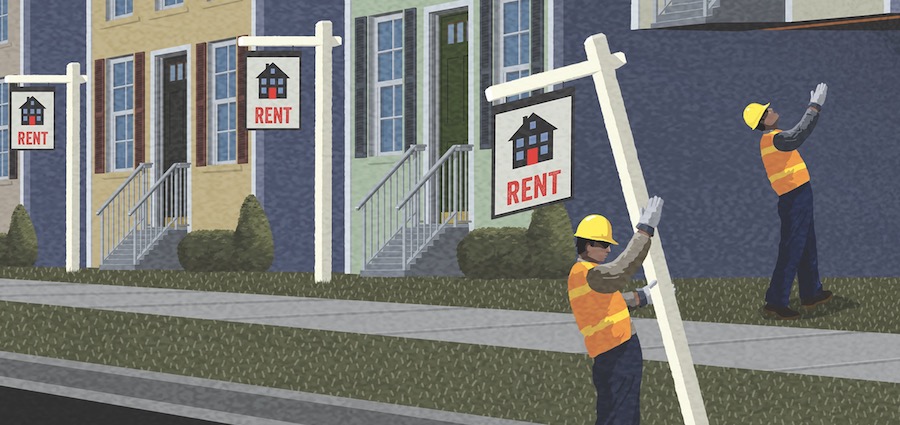
Manufactured to Rent: Lowering Costs and Price Points
When Jerry Ellenburg, chairman and CEO of ERC Homebuilders, in Riverview, Fla., came across a piece of affordable land in Zephyrhills, 30 miles northeast of Tampa, a light bulb went off.
Zoned for a mobile-home park, the parcel inspired Ellenburg to shift from a $100 million deal for site-built single-family rentals to a dedicated rental community (DRC) of 60 HUD-code homes, significantly lowering his cost to build and his rental price point while still providing new, 1,300-to-1,500-square-foot homes to a willing and waiting market. “I discovered a whole cast of characters, where $1,400 a month for a new, three-bedroom, two-bath home with a two-car garage is worth driving another 5 miles to get,” he says. The kicker, he adds, is that renters at Zephyrhills will look out their windows and see nothing but other new homes, as well as professionally maintained landscaping and tenant management. ”It’s an affordable aesthetic.”
"I discovered a whole cast of characters, where $1,400 a month for a new, three-bedroom, two-bath home with a two-car garage is worth driving another 5 miles to get." —Jerry Ellenburg, CEO of ERC Homebuilders
This new take on the SFB2R model has not only attracted tenants (40 units secured since September), but also investors, including the one Ellenburg engaged for the site-built project. “They’re all over me on this,” he says, as he closes in on financing for this and a 40-unit project to follow. “They love the speed to revenue [fully leased within a year], lower costs, and profit potential.” The model, as with site-built DRCs, also provides flexibility for Ellenburg and his investors.
"We can either build them, fill them up, and sell the whole community to a landowner-operator, or build up our own rental portfolio,” he says, the former offering higher profitability, the latter leveraging better investment deals for future projects. Ellenburg is so confident in his as yet untested model that he has four more parcels in Florida on his radar and plans to take the concept across 10 states. “I think the affordability factor will drive everyone to this,” he says. “We’re going to wake up two or three years from now delivering 2,000 to 3,000 units a year.”
The Investor Angle: Institutional Investors Get Into the Build-to-Rent Game
For better or worse, institutional investors are actively pursuing rental homes ... and they aren’t just buying, they’re building. While it’s true that more people are choosing to rent, it’s also true that homeownership—despite the recent uptick in sales—remains beyond the reach of many Americans. Some 5 million existing homes have been converted to rentals, and there are now nearly 49 million renter households in the U.S., 12 million single-family detached rental homes, and another 2.8 million leased townhouses, according to RCLCo estimates.
The vast majority of these SFRs are owned by individuals or small, usually local, investors. The two biggest SFR real estate investment trusts—Invitation Homes and American Homes 4 Rent—combined own about 135,000 units, or less than 2% of the total. But institutional investors are avid for this product. When Blackstone Group sold off its remaining holdings in Invitation Homes last year, buyers included JP Morgan Chase’s asset management division. There are now at least 25 institutional landlords in the SFR space, according to the Amherst Capital Management subsidiary of Amherst Holdings.
Last February, Amherst Holdings spent $2.3 billion to acquire Front Yard Residential, with more than 15,000 SFR homes. “Scale in this industry is very important,” Drew Flahive, president of subsidiary Amherst Residential, told Crain’s Chicago Business. Wall Street’s specter over the single-family rental market has some critics worried. The New York Times Magazine published a scathing article that blamed the SFB2R market in general for diverting investment capital away from construction of affordable for-sale housing. Still, the segment pushes forward. “It’s a unique asset class, in that you have investors from home building, scattered-site single-family, and the multifamily world all converging on it as it starts to gain notoriety and traction,” says Sudha Reddy, managing principal at Haven Realty Capital.
An Alliance to Growth: Christopher Todd Communities and Taylor Morrison
Todd Wood, CEO of Christopher Todd Communities (CTC), sees himself as a disruptor. In the late 1990s, his family started an organic bakery, Alpine Valley Bread, in Mesa, Ariz., for which a customer base grew to include Costco and Kroger. In late 2015, that business sold for $120 million to Flowers Foods.
When Wood started investigating the rental housing market as another business opportunity, what he saw were “white bread” garden apartments with no amenities, he says. His vision was to provide tenants with “a horizontal, detached, luxury high-tech apartment experience, ‘A New Way of Life’ for people who choose to rent.”
Prior to his company’s partnership with Taylor Morrison last spring, CTC had a portfolio of 2,500 rental homes in the Phoenix market. Those rentals, claims Wood, have a 75% to 80% retention rate (compared with a national average of 45% to 55%), and 20% to 30% higher rents than nearby garden apartments.
CTC’s one- and two-bedroom rental houses are all single story, ranging from 700 to 1,050 square feet. Each home has an outdoor backyard and is equipped with smart technology such as keyless entry, climate control, doorbell cameras, lighting, and security cameras, all operable from the tenant’s smartphone or tablet.
The communities offer tenant access to resort-style swimming pools, outdoor fire pits, and event lawn and open space areas. “We knew we had something special and disruptive," Wood says. "And we wanted to deliver consistent product as we moved across the country.”
The challenge was who was going to build it? Wood chose Taylor Morrison as a partner primarily because of the company's reputation for building high-quality product.
In this arrangement, Wood sees CTC acting as an “asset maximizer” for Taylor Morrison. “We have the branding experience,” he explains, “and if Taylor Morrison decides to sell [its rental houses] to investors, we will go to the investor/owner and explain to them that we can deliver an asset with the highest rate of return.”
